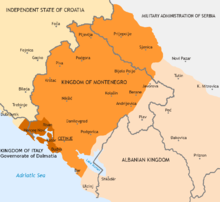Uprising in Montenegro
| Uprising in Montenegro | |||||||
|---|---|---|---|---|---|---|---|
| Part of World War II in Yugoslavia | |||||||
 The proposed Italian puppet state Kingdom of Montenegro |
|||||||
|
|||||||
| Belligerents | |||||||
|
|
|
||||||
| Commanders and leaders | |||||||
| Units involved | |||||||
|
|||||||
| Strength | |||||||
|
32,000 people according to Yugoslav sources | ||||||
| Casualties and losses | |||||||
|
5,000 died and 7,000 wounded | ||||||
|
Civilian casualties:
|
|||||||
The Uprising in Montenegro (Montenegrin: Ustanak u Crnoj Gori), commonly known as the 13 July Uprising (Montenegrin: Trinaestojulski ustanak) was an uprising against Italian occupation forces in Montenegro (Axis occupied Yugoslavia). Initiated by the Communist Party of Yugoslavia on 13 July 1941, it was suppressed within six weeks, but continued at a much lower intensity until December 1941. The insurgents were led by a combination of communists and former Royal Yugoslav Army officers from Montenegro. Some of the officers had recently been released from prisoner-of-war camps following their capture during the invasion of Yugoslavia. The communists managed the organisation and provided political commissars, while the insurgent military forces were led by former officers. The entire nation rejected the privileged position offered by its occupiers, rejected the capitulation in order to fight for Yugoslavia, together with "Russia" (the nationalist insurgents perceived the Soviet Union as Russia at the beginning of the uprising).
Within three weeks of the start of the uprising, the insurgents managed to capture almost all the territory of Montenegro. The Italian troops were forced to retreat to their strongholds in Pljevlja, Nikšić, Cetinje and Podgorica. The main commanders included the former officers Colonel Bajo Stanišić and Major Đorđije Lašić, with Captain Pavle Đurišić emerging as one of the principal leaders after he distinguished himself during the successful attack he led on Berane alongside communist forces.
...
Wikipedia
